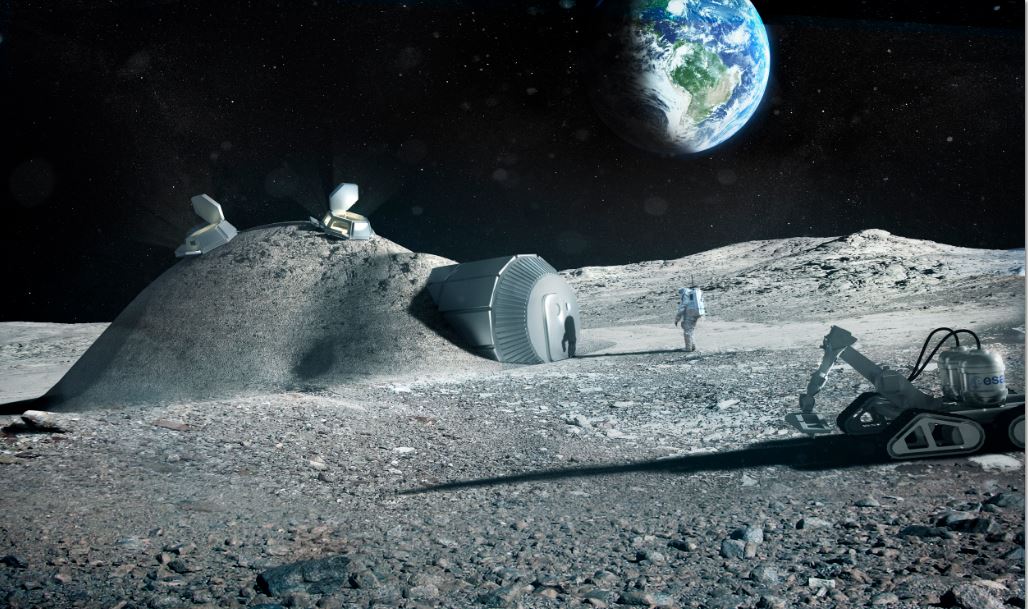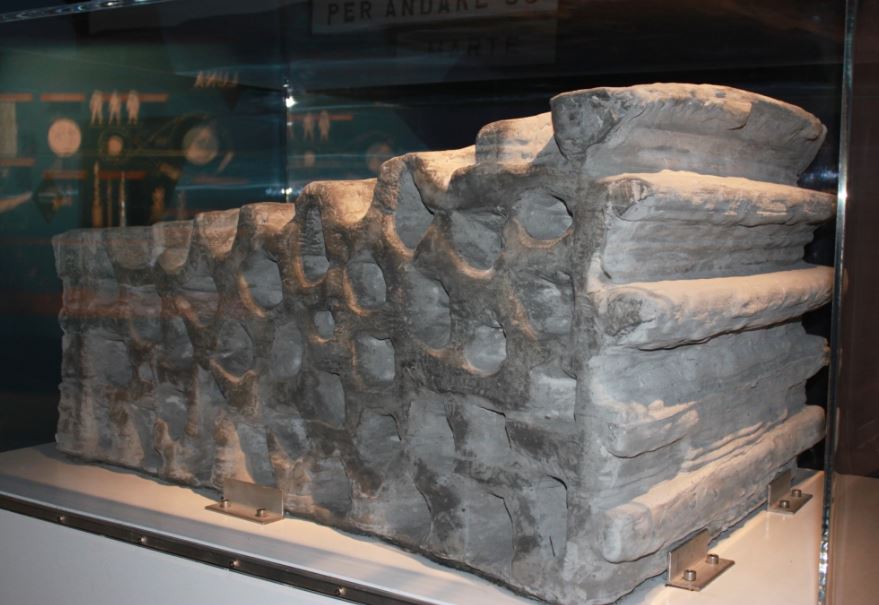A crazy Moon Village project has been announced by European Space Ageny boss Jan Woerner. It was Prof. Warner himself who described his idea as ‘crazy’. He would like the International Space Station, which will be shut down in 2024, to be succeeded by a Moon Village, which would be constructed by robots and 3D printers using moon dust and rocks as raw materials.
Material on the Moon would be used, for example, to build a large observatory to look into space. On the far side of the Moon, looking into space is particularly interesting, Prof. Woerner believes.
Johann-Dietrich ‘Jan’ Wörner, 61, a German civil engineer, university professor and former president of Technische Universität Darmstadt, succeeded Jean-Jacques Dordain as Director General of the European Space Agency on 1st July, 2015.
 Jan Woerner explaining his Moon Village idea during a press conference at ESA headquarters in Paris. He also provided an overview of ESA’s achievements in 2015 and the opportunities ahead in 2016. (Image: esa.int)
Jan Woerner explaining his Moon Village idea during a press conference at ESA headquarters in Paris. He also provided an overview of ESA’s achievements in 2015 and the opportunities ahead in 2016. (Image: esa.int)
Moon Village the ideal successor of ISS
In a press conference, Prof. Woerner said:
“I looked into the requirements I see for a project after ISS. As of today, I see the Moon Village as the ideal successor of the International Space Station for (space) exploration.”
Prof. Woerner envisages several nations, economic blocs and space exploration groups collaborating in the Moon Village project, including the European Space Agency (ESA), the National Aeronautics and Space Administration (NASA), Roscosmos State Corporation for Space Activities (Роскосмос), the China National Space Administration (CNSA or 国家航天局), Japan Aerospace Exploration Agency (JAXA – 国立研究開発法人宇宙航空研究開発機構), and the Canadian Space Agency (CSA).
Experts globally could contribute knowledge, expertise, technology, and even manpower (spacemen and women) for preparations for the Mars mission.
Regarding a mission to Mars, Prof. Woerner said it is clear nobody is talking about flying directly to Mars within the next five to ten years. Mars is a very long way away, not only from the distance point of view, but also regarding what we have to do on the technology side.
 An artist’s depiction of a multi-dome lunar base being built, based on the 3D printing concept. Once completed, the inflated domes would be covered with a layer of 3D-printed lunar regolith by robots to help protect the inhabitants against micrometeoroids and space radiation. (Image: www.esa.int. Credits: ESA/Foster + Partners)
An artist’s depiction of a multi-dome lunar base being built, based on the 3D printing concept. Once completed, the inflated domes would be covered with a layer of 3D-printed lunar regolith by robots to help protect the inhabitants against micrometeoroids and space radiation. (Image: www.esa.int. Credits: ESA/Foster + Partners)
“To use the Moon as a stepping stone or as a pit-stop, that’s crucial, because we have to test, for instance, how to build structures on a planet, instead of bringing all the stuff there,” he said.
Scientific research could be conducted on the Moon, as it currently is onboard the ISS, he added.
ISS commitment by all to 2024, except Europe
The United States announced its intention in 2014 to keep the ISS operating until 2024, which postponed its retirement by at least four years. ESA is only committed until 2020, and a number of European countries are not too keen on being asked to cover costs beyond that date.
Russia, on the other hand, which is an ISS partner, says it is looking at the option of building its own space station when the current collaboration ends.
 Building a future Moon Village could be made much simpler using a 3D printer and local materials rather than bringing everything from Earth. Some structures may have to be made on Earth and flown over, but the bulk could be built using Moon dust and rocks. (Image: ESA/Foster + Partners)
Building a future Moon Village could be made much simpler using a 3D printer and local materials rather than bringing everything from Earth. Some structures may have to be made on Earth and flown over, but the bulk could be built using Moon dust and rocks. (Image: ESA/Foster + Partners)
The International Space Station is a joint venture of NASA, ESA, Roscosmos, CSA and JAXA. All members, except for the European Union, have agreed to commit to the ISS mission until 2024.
Prof. Woerner said yesterday that the ISS has great value and expressed hopes that European Union members would decide to carry on until 2024.
Moon Village with multiple uses and users
According to Prof. Woerner, a lunar village would have several different types of uses and users.
Prof. Woerner explained:
“Maybe one country is more interested in science, another may be a private company interested in mining, and another may be interested to use the Moon as a stepping stone for further exploration.”
Nobody needs to make a formal decision now, ESA’s boss insisted, adding that he was simply airing his own ideas in public.
 Initially, robots would be sent to the Moon first, and would prepare the surface for humans. (Image: ESA/Foster + Partners)
Initially, robots would be sent to the Moon first, and would prepare the surface for humans. (Image: ESA/Foster + Partners)
As soon as the best location on the Moon to build the village is identified, nations, agencies and other interested groups can then decide whether they want to be involved in the project, and to what extent.
Both China and Russia have Moon missions planned. He suggested that it might be more beneficial for them, and everybody else interested in space exploration, to combine resources, technology and expertise.
How many would live in the Moon Village?
When asked how many people would live in this lunar village, Prof. Woerner jockingly responded that it is an interesting question, as would be deciding who should be mayor of that village.
 This building block, weighing 1.5 tonnes, was created as a demonstration of 3D printing techniques using Moon dust. The design is based on a hollow closed-cell structure – like bird bones – to give a good combination of both strength and weight. (Image: www.esa.int)
This building block, weighing 1.5 tonnes, was created as a demonstration of 3D printing techniques using Moon dust. The design is based on a hollow closed-cell structure – like bird bones – to give a good combination of both strength and weight. (Image: www.esa.int)
Prof. Woerner explained:
“It is not a question of inhabitants. I am sure there would be permanently, astronauts or cosmonauts, but the main idea of the village is not to build some houses, a church and a community hall, or something like that.”
“The basic idea is to put together the different capabilities. One country may bring in a good robot producing 3D printing, another country might bring in, for instance, a very nice rover, and a third country might bring in some astronauts.”
Video – 3D Printing
In other words, it is not a question of how many inhabitants the village will have, but rather how many participating nations and organizations there will be, and what they will be contributing.
The whole project would not be expensive, if one looks at the cost-per-inhabitant of the participating nations, rather than the total round number, Prof. Woerner explained. The annual cost would be less (per person) than the cheapest metro (subway, underground) ticket in Paris.
Cost versus human inspiration value
Regarding costs, Prof. Woerner added:
“Humans need this spirit of inspiration. I am not so ready to calculate the benefits only in dollars or in euros, because I think inspiration is what we need for the future.”
“If we can drive inspiration, this has a much higher value than any other.”
When asked whether he would go to the Moon Village, Prof. Woerner said he would, and pointed out that he is still younger than astronaut John Glenn, the first American to orbit the Earth and then the oldest one when he orbited our planet the second time.
Earlier this month, during a two day conference – ‘International Symposium on Moon 2020-2030’ – held at the Space Research and Technology Centre of the European Space Agency (ESA/ESTEC), 35km south-west of Amsterdam International Airport in The Netherlands, ESA scientists said robots could land on the Moon first and prepare the surface for humans, who would follow later.
During their presentations, the European researchers showed what the Moon base would look like and how the human pioneers would live.
Video – The idea of a Moon Village
CNNi talks to Jan Woerner about his proposal for a Moon Village.
